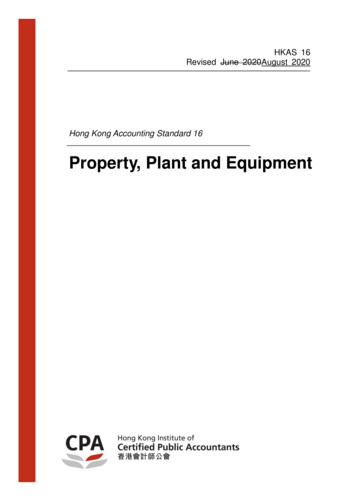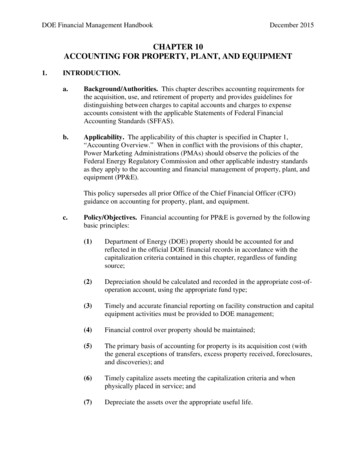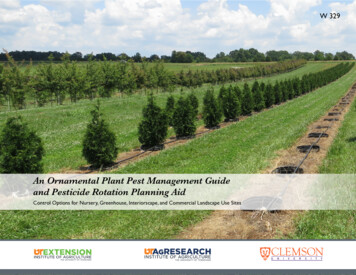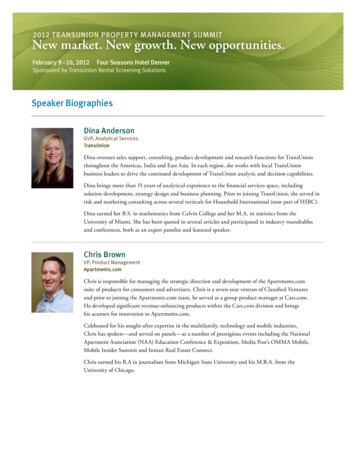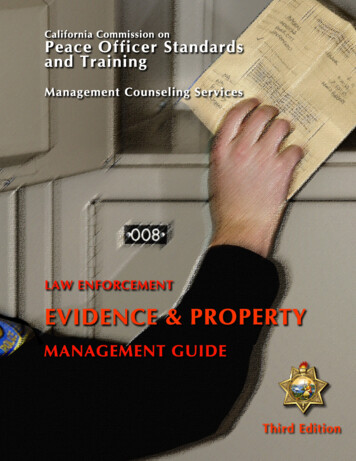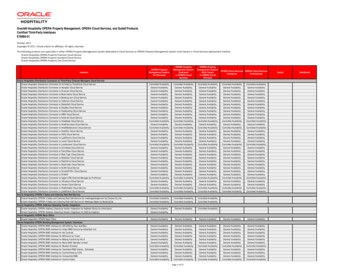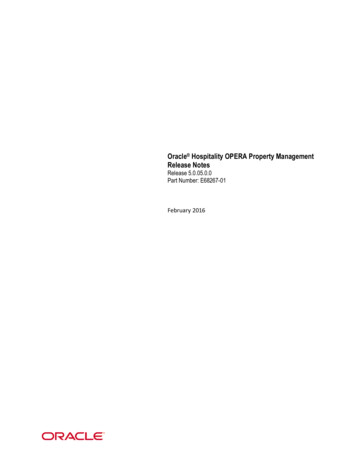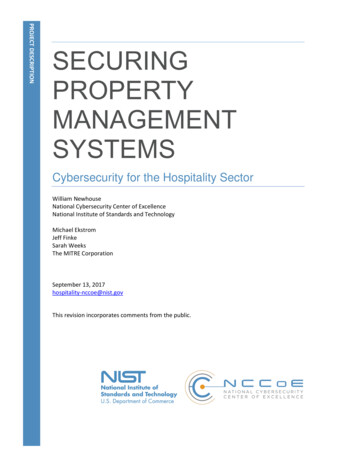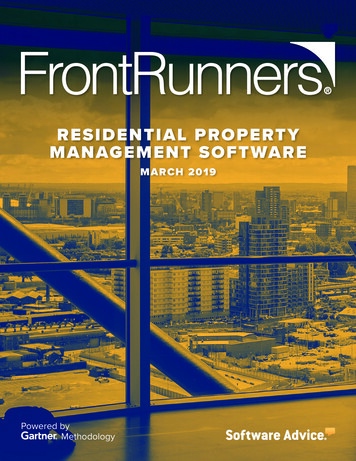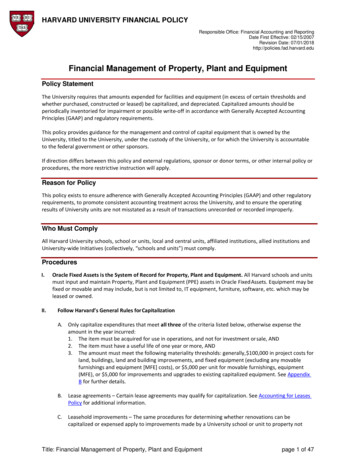
Transcription
HARVARD UNIVERSITY FINANCIAL POLICYResponsible Office: Financial Accounting and ReportingDate First Effective: 02/15/2007Revision Date: 07/01/2018http://policies.fad.harvard.eduFinancial Management of Property, Plant and EquipmentPolicy StatementThe University requires that amounts expended for facilities and equipment (in excess of certain thresholds andwhether purchased, constructed or leased) be capitalized, and depreciated. Capitalized amounts should beperiodically inventoried for impairment or possible write-off in accordance with Generally Accepted AccountingPrinciples (GAAP) and regulatory requirements.This policy provides guidance for the management and control of capital equipment that is owned by theUniversity, titled to the University, under the custody of the University, or for which the University is accountableto the federal government or other sponsors.If direction differs between this policy and external regulations, sponsor or donor terms, or other internal policy orprocedures, the more restrictive instruction will apply.Reason for PolicyThis policy exists to ensure adherence with Generally Accepted Accounting Principles (GAAP) and other regulatoryrequirements, to promote consistent accounting treatment across the University, and to ensure the operatingresults of University units are not misstated as a result of transactions unrecorded or recorded improperly.Who Must ComplyAll Harvard University schools, school or units, local and central units, affiliated institutions, allied institutions andUniversity-wide Initiatives (collectively, “schools and units”) must comply.ProceduresI.II.Oracle Fixed Assets is the System of Record for Property, Plant and Equipment. All Harvard schools and unitsmust input and maintain Property, Plant and Equipment (PPE) assets in Oracle Fixed Assets. Equipment may befixed or movable and may include, but is not limited to, IT equipment, furniture, software, etc. which may beleased or owned.Follow Harvard’s General Rules for CapitalizationA.Only capitalize expenditures that meet all three of the criteria listed below, otherwise expense theamount in the year incurred:1. The item must be acquired for use in operations, and not for investment or sale, AND2. The item must have a useful life of one year or more, AND3. The amount must meet the following materiality thresholds: generally, 100,000 in project costs forland, buildings, land and building improvements, and fixed equipment (excluding any movablefurnishings and equipment [MFE] costs), or 5,000 per unit for movable furnishings, equipment(MFE), or 5,000 for improvements and upgrades to existing capitalized equipment. See AppendixB for further details.B.Lease agreements – Certain lease agreements may qualify for capitalization. See Accounting for LeasesPolicy for additional information.C.Leasehold improvements – The same procedures for determining whether renovations can becapitalized or expensed apply to improvements made by a University school or unit to property notTitle: Financial Management of Property, Plant and Equipmentpage 1 of 47
HARVARD UNIVERSITY FINANCIAL POLICYResponsible Office: Financial Accounting and ReportingDate First Effective: 02/15/2007Revision Date: 07/01/2018http://policies.fad.harvard.eduowned by that school or unit. Generally, improvements made to leased premises are capitalized if theymeet the above criteria and qualify as alterations, renovations, renewals or replacements. Theseleasehold improvements are depreciated over the shorter of the life of the asset or external lease plusextensions (see Appendix B).D. When building or fabricating assets, acquiring land, land improvements, buildings or equipment, allsignificant expenditures that are necessary to obtain and prepare the asset for its intended use aregenerally capitalized. In addition, costs such as freight, insurance, installation and assembly arecapitalizable. The capitalization guidelines differ for each type of asset (see Appendix B).III.E.Repair and maintenance expenses associated with recurring work required to preserve or immediatelyrestore a facility or a piece of equipment to such condition that it can be effectively used for itsdesignated purposes should be expensed as incurred. For additional guidance, see the “Repairs andMaintenance” section of Appendix B.F.Works of art, collections and books:1. Items purchased as part of a collection or held for exhibit should be expensed and not recorded asa capital asset. In accordance with FASB guidelines, Harvard does not capitalize its collections,including works of art, historical treasures, and books.2. Works of art that are purchased for the sole purpose of furnishing an office should follow thepolicies for purchasing office furniture and fixtures. Purchases under 5,000 should be expensedand those over 5,000 should be capitalized.Follow Specific Rules for Capitalizing Equipment – See Appendix B for additional guidanceA.Costs for assets are accumulated through accounts payable transactions (HCOM, Concur and WIP forCorporate Card) or internal billing charges. PCard may not be used for purchased equipment, furnishing,software or vehicles. Schools or units may have more restrictive policies, contact your Equipment orFinance Office for additional guidance.Note: When using federal funds, areas must follow the Uniform Guidance requirements regardingavoiding unnecessary and duplicative purchases and contractor selection justification. See theProcurement Policy for additional guidelines.B.Code moveable equipment, furnishings, software and vehicles costing 5,000 or more to object codes6800-6869. Individual items (that are not part of multi-component equipment) costing less than 5,000,even if the total purchase exceeds 5,000, should not be capitalized but expensed as incurred; useobject codes 6710-6789 to capture these acquisitions. See the Software Policy for further guidance onthe capitalization of software licenses and datasets. Local policies may require tracking of equipmentbelow the capitalization threshold; contact your school or unit financial office or equipment managerfor further guidance.C. Multicomponent equipment is comprised of individual components of commercially-availableequipment or materials purchased together that are assembled to operate as a system (e.g., amicroscope, camera, laser, optics, etc.). Component parts of one piece of equipment must beaccumulated and capitalized if, at the time of requisition, the cost is 5,000 or more. Componentpieces can be purchased from one or more vendors. In addition, costs such as freight, insurance,installation, and assembly are capitalizable. See “Equipment” in Appendix B for additional information.D. Fabrications consist of non- ‐expendable, tangible property, physically constructed by Harvardpersonnel. Fabrications have aggregate capitalizable costs of 5,000 or more, have an expectedcompletion date, and a useful life of one year or more. Fabrications are made up of parts andTitle: Financial Management of Property, Plant and Equipmentpage 2 of 47
HARVARD UNIVERSITY FINANCIAL POLICYResponsible Office: Financial Accounting and ReportingDate First Effective: 02/15/2007Revision Date: 07/01/2018http://policies.fad.harvard.edumaterials combined or manufactured to work together as an identifiable unit and are not simply amulticomponent assembly of separate items. Fabrications created for delivery to a third-party shouldbe treated as inventory. Fabrications are excluded from indirect costs and are capitalized anddepreciated as an asset of the University once placed in service. (See Appendix B and Appendix F.)E.Aggregate fabrication costs for constructed equipment (Work in Progress - WIP) by project using objectcodes 6811 and 6812. Once completed, areas must place the assets into service (PIS) by working withtheir school or unit Central Equipment Manager or school or unit Finance Office, who will work withFinancial Accounting and Reporting (FAR). See “Fabrications - Work in Progress (WIP)” in Appendix B foradditional information.F.Improvements and enhancements (also known as betterments) to existing capitalized equipment mustmeet the criteria listed in section II.A.3. It is added as a new “child” asset to the original capitalizedequipment. (See Appendix B)G. Title transfers: Contact Financial Accounting and Reporting (FAR) for accounting guidance when title toequipment is transferred to Harvard (e.g., an incoming faculty member or a donation) or betweenHarvard school or unit.H. Equipment for which Harvard does not hold title (see Table in Appendix A):1. Government-titled equipment and government-furnished property: under some sponsored awards,the government keeps the title to certain equipment. In cases where the government furnishes theequipment at no cost, Harvard does not own the equipment but must still record it for trackingpurposes, and the assets should be recorded in Oracle Fixed Assets at zero value. Additionalprocedures apply in such cases; see Appendix A for more information.2. Faculty transfers: occasionally, an incoming faculty member brings equipment to Harvard but doesnot transfer title to the equipment to Harvard. In these cases, Harvard does not own theequipment but must still record it for tracking purposes, and the assets should be recorded inOracle Fixed Assets at a net book value of zero. Refer to Appendix B for more information.3. Leased equipment, please see the policy on Accounting for Leases.4. Equipment on loan to Harvard must be recorded for tracking purposes. The assets should berecorded in Oracle Fixed Assets at zero valueI.Equipment Assets Placed in Service (PIS)An equipment fabrication project must be placed in service when:the asset has been sufficiently developed and is generating the intended useful results ANDthe aggregate project costs meet the capitalization threshold.Complete the Notification to Place in Service Work in Progress form and submit it toFAR Fixed Assets@harvard.edu.School or Units must review all their equipment Work in Progress (WIP) every 6 months to determine ifthey should be placed into service, written off or documented as to the reason the project shouldremain open. This review must be aligned so as to ensure one of the bi-annual reviews is done close toyear end (i.e., as of May or June). Exceptions for inactive fabrications remaining open should be rare.For any school/unit/area with Sponsored WIP, refer to Appendix A for additional review requirementsrelated to WIP on awards that are closing in the next 6 months.For non-debt financed WIP, the school and units must notify FAR when projects are ready to be placedinto service. For debt financed WIP, the school and units must notify both FAR and the Office ofTreasury Management (OTM) when projects are ready to be placed into service. For additionalguidance, see the Equipment Work in Progress section of Appendix B.Title: Financial Management of Property, Plant and Equipmentpage 3 of 47
HARVARD UNIVERSITY FINANCIAL POLICYResponsible Office: Financial Accounting and ReportingDate First Effective: 02/15/2007Revision Date: 07/01/2018http://policies.fad.harvard.eduIV. Specific Rules for Capitalizing Buildings, Land, and ImprovementsA. Capitalizing building, land and improvement projects requires a formal project proposal (PP),construction authorization (CA) and construction close request (CCR) which are completed through theCAPS automated system. See Capital Project Services (CAPS) for details.B.Placing in Service (PIS): If any one of the following conditions is met, a building project is consideredcomplete and must be placed in service (PIS) and the project fully or partially closed:1. A Certificate of Occupancy (CO) or Temporary Certificate of Occupancy (TCO) if the use of the assetcommences as of the TCO date, has been issued,2. If a CO or TCO is not necessary for the project, a Certificate of Substantial Completion has beenreceived from the contractor, or municipal sign-offs on construction permits have been receivedthat allow use of the space/asset.C.Closing a Project: When a project is complete, schools and units process a Construction Close Request(CCR) through the CAPS system. The CAPS system notifies FAR to ensure the full costs of the assets areplaced into service. All of the costs aggregated in the CIP object codes are placed in service (PIS) eitheras a Facility Buildings PIS or Movable Furnishings & Equipment (MFE). The Placed in Service date isbased on the CO, TCO or permit signoff date. If no certificate permit signoff is needed, FAR suggests theschool or unit use the date that approximates when the property was put in use or the date of the lastposted purchase.D. Soft or Partial Close: A soft or partial close is required if a project is expected to incur additional costs,and the project meets the following criteria:1. the project meets the criteria listed under Section IV.B. above, and2. the project has incurred capital costs, excluding MFE, of greater than 1,000,000 for large schoolsor units (FAS, HMS, HBS, SPH) or 500,000 for small schools or units (all other school or units),.If a partial close is required per the above, the request should be submitted within two months of theissuance of the Certificate of Occupancy (whether permanent or temporary), the permit signoff, orother events triggering the partial close.Schools or units submit a partial close request through the CAPS system on the ConstructionAuthorization (CA) form. The placed in service date is determined based on the CO permit signoff date.If no certificate or permit signoff is needed, FAR and the CAPS office will work with the School or unit todetermine the appropriate date to use. The date that approximates when the property was put in useor the date of the last posted purchase may be suggested.When a partial close is processed, all non-MFE costs incurred to date are placed in service. MFE is notplaced in service until the final close. If a project is debt-funded, debt will be issued, and debt servicewill begin. Depreciation back to the placed in service date is calculated and recorded in the month thatFAR records the partial close. Harvard uses a full-month convention for depreciation, and thus a fullmonth of depreciation is taken for the month that the project was partially closed.The CIP activity will remain open, and costs will continue to be charged to the CIP object codes until theproject is 100% complete. Upon final completion of the project and submission of the CCR, theadditional costs incurred since the partial close are placed in service, and the activity is closed (finalclose). All the MFE costs will be placed in service at the time of the final close. The loan for debt-fundedprojects is adjusted to the final amount. Any excess funding on equity-funded projects is returned tothe School or unit funding the project. The placed in service date for these additional costs will be thedate used in the partial close, and the depreciation adjustment on the final costs will be recorded in theTitle: Financial Management of Property, Plant and Equipmentpage 4 of 47
HARVARD UNIVERSITY FINANCIAL POLICYResponsible Office: Financial Accounting and ReportingDate First Effective: 02/15/2007Revision Date: 07/01/2018http://policies.fad.harvard.edumonth the final close is completed.E.Phased projects: Phased projects are projects that have separate and distinct phases that areindependent of one another, (i.e., one phase can be placed in service before other phases begin orend). In phased projects, each phase can have a separate placed in service date. In order to haveseparate and distinct placed in service dates, separate CIP activities must be established for each phase.(Each CIP activity can only have one placed in service date.) Once completed phases are placed intoservice, depreciation and debt service begin on those respective phases.F.Final Closes: Once the CCR is submitted and approved, FAR capitalizes the full capital costs of theproject and the CIP activity is closed. No additional spending can be charged to the project, and anyremaining costs are expensed as incurred. Depreciation starts in the month the asset is placed in serviceand the Oracle system will record any catch-up depreciation back to the appropriate month. Debtservice begins the month the close or partial close was recorded (e.g., if a project close is recorded inFebruary 2017 with a PIS date of November 2017, the debt service begins in February). It is importantto note that the placed in service date should be reviewed for accuracy and that this is necessary forbudget/forecasting purposes.G. Depreciation Method: Harvard begins depreciation in the month the asset was purchased and placedinto service OR the date a project (CIP or WIP) is closed (full or partial) and placed into service. A fullmonth of depreciation will be recorded in the first month. Depreciation is recorded each month as apart of the month end close process.Harvard suggests the use of standard useful lives, which are detailed in Appendix C. Different lives,where applicable, can be used if justified by the facts and circumstances and approved by FAR. Schoolsand units may record depreciation expense to the school or unit-level org, to department orgs, or acombination of the two.V. Inventory and Asset ManagementA. Buildings, land, improvements, fixed equipment and leasehold improvements: Per University InternalControls, schools and units must show documentation review of asset impairment or retirement forland, buildings and leasehold improvements on an annual basis. See Property, Plant and EquipmentInternal Controls matrix.B.Refer to disposals, dispositions, and impairments covered in Appendix D.C.Individual MFE equipment assets costing over 25,000 that are purchased as part of a capital projectrequire special treatment. Equipment managers or other school personal are required to identify theseassets and create a separate asset in Oracle Fixed Assets for the purposes of tracking and inventory.D. Moveable Equipment:1. Identification of EquipmentOracle Fixed Assets is Harvard’s system of record for all property, plant and equipment assets.Areas must ensure all asset information is entered into Oracle Fixed Assets and kept current. Uponplacement in service of capital equipment, areas must maintain records that include a descriptionof the equipment, a serial number or other unique identification number, the source of funding,who holds title, the acquisition date and cost, the location, use and condition status, and anyultimate disposition data. Equipment records must be maintained and updated in such a mannerthat allows for an item of equipment, whether at Harvard or at an off-campus site, to be locatedwithin thirty days.Title: Financial Management of Property, Plant and Equipmentpage 5 of 47
HARVARD UNIVERSITY FINANCIAL POLICYResponsible Office: Financial Accounting and ReportingDate First Effective: 02/15/2007Revision Date: 07/01/2018http://policies.fad.harvard.edu2.Tagging EquipmentIn order to maintain effective equipment identification, areas must affix a unique identification tagto capital equipment. These tags facilitate the area’s equipment inventory control by enablingindividuals to match pieces of equipment to their associated information, as required by federalregulations. In cases where items cannot be physically tagged (e.g., too small, temperaturesensitive), or in cases where the tag would interfere with use or operation, schools and units mustcomplete and upload into Oracle Assets a Untaggable Asset Form or similar documentation. Allequipment that is the property of the federal government, whether Government Titled Equipment,Government Furnished Property, or conditionally-titled, must be tagged with an additional tagidentifying it as government property. Refer to Appendix A for additional information on theseclassifications.3.Inventory ControlA full physical inventory of all equipment purchased
Oracle Fixed Assets at a net book value of zero. Refer to Appendix B for more information. 3. Leased equipment, please see the policy on Accounting for Leases. 4. Equipment on loan to Harvard must be recorded for tracking purposes. The assets should be recor

